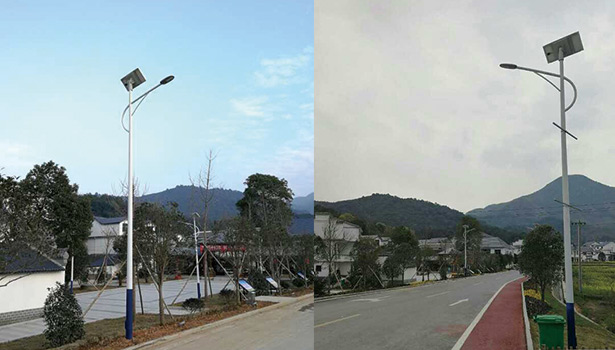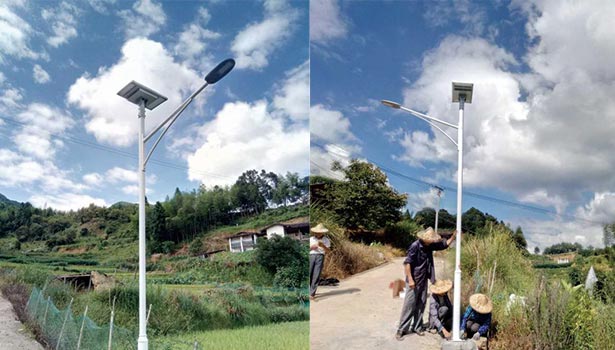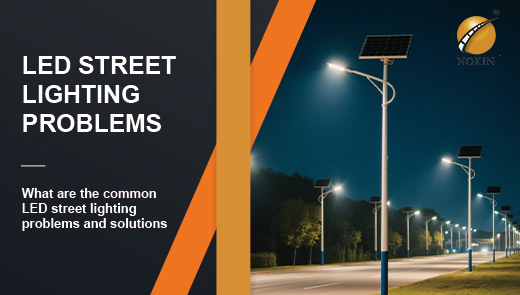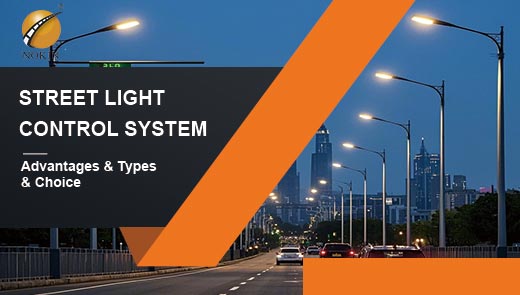What are the common quality problems of LED street light
Importance of LED street light quality
The quality of street lighting is crucial
In modern urban construction, LED street lights play an extremely critical role. Especially LED street lights, it can light up the road at night, for pedestrians and drivers to create a safe night travel environment.
If the quality of street lights is poor and the lighting performance is unstable, the subsequent maintenance and replacement work will face many difficulties. This will not only threaten the safety of pedestrians and drivers, but also significantly increase the burden of public expenditure on urban construction.
External Concerns about LED street lights
CNN Health has published an article discussing the problems of LED street lights. The article mentioned two major issues of concern: discomfort and glare. LED lights are concentrated, high in blue light, and prone to serious glare, causing the pupils of the eyes to constrict. Blue light scatters more in the human eye than longer wavelengths such as yellow and red, and to a certain extent can damage the retina. The American Medical Association (AMA) statement also pointed out that LED street lights may affect the human body's circadian rhythm. But are these problems due to the characteristics of LED street lights themselves, or are they related to the design and quality of street lights? Next, this article will analyze the common problems of LED street lights.

What are the common quality problems of LED street light and the solutions
LED driver failure
Problem performanceLED driver is called the core of the entire LED street light system, responsible for regulating electricity, to ensure the smooth operation of street lights. Once the driver fails, the street light will flicker, dim or even go out completely.
Poor driver quality: low quality drivers have unstable voltage regulation, making it difficult to provide stable power output.
Poor heat dissipation: Poor heat dissipation design leads to heat buildup when the drive is working, which in turn triggers the failure.
Power surge impact: Sudden surges in the power grid may instantly breakdown the drive circuit.
Countermeasures
Choose high-quality brand drives: such as Philips, Meanwell, OSRAM and other well-known brands of drives, the quality is more secure.
Focus on the protection function: choose the driver with built-in thermal protection and surge protection function.
Consider the efficiency and life: prioritize the selection of efficiency ≥ 90% and long service life of the driver.
Poor quality LED chips
Problem performanceThe quality of LED chips is directly related to the brightness, efficiency and service life of street lights. Using cheap chips, street lights not only lack of brightness, but also accelerate aging.
Reasons for failure
Low quality chips: low-cost general-purpose LED chips, poor durability, easy to damage.
color temperature inconsistency: there are deviations in the color temperature of the chip, resulting in street light emitting color incoherence.
Low luminous efficiency: these chips cannot efficiently convert electrical energy into light energy, resulting in energy waste.
Countermeasures
Choose reliable chip brands: Chips from brands like Lumileds, OSRAM, CORE, etc. are of reliable quality.
Focus on chip efficiency: pick chips with luminous efficiency ≥160lm/W.
Ensure color consistency: select the chip that has been graded and controlled to ensure uniform color.
SPD function (surge protector) problems
Problem performanceIf there is no effective protection measures, sudden power surge may instantly burn down the LED street light.
Failure causes
- Lightning strike or grid instability: A direct lightning strike or violent fluctuations in grid voltage can produce powerful surges.
- Weak or missing surge protection: No or low performance surge protector is installed in the street light system.
Countermeasures
- Install high-performance SPDs: Choose surge protectors with 10kV - 20kV surge protection capability.
- Install voltage regulators: In areas with frequent voltage fluctuations, install voltage regulators to stabilize the voltage.
- Make good grounding: Ensure that the street lighting system is well grounded to prevent electrical damage.

Lower IP/IK Protection Rating
Problem PerformanceLED Street lights are exposed outdoors for a long time and need to withstand rain, dust and physical impacts, and a low level of protection is unable to withstand these external factors.
Reasons for failure
- Low IP rating: means that the solar street lights is not sufficiently protected against water and dust.
- IK Weak rating: indicates that the street light is easily damaged by impact.
Countermeasures
- Choose high IP grade products: such as IP65/IP66 grade street lights, which are good at water and dust protection.
- Focus on IK rating: Adopt IK08/IK10 rated lamps and lanterns shells to enhance impact resistance.
- Select corrosion-resistant materials: to adapt to the harsh outdoor environment.
Poor heat dissipation
Problem PerformanceOverheating will accelerate the damage of LED lamps and make their brightness decrease gradually with time.
- Defective design of heat sink: the heat sink can not effectively dissipate the heat, resulting in heat accumulation in the lamp.
- Poor thermal management: The overall thermal management system is not well designed, affecting the performance of the LED lamp.
- High ambient temperature: High temperature environment will aggravate the aging of LED lamps.
Countermeasures
- Adopt high-quality heat dissipation materials: such as die-casting aluminum shell, superior heat dissipation performance.
- Increase the area of heat sink: Improve the heat dissipation efficiency to ensure the stable work of LED lights.
- Select high temperature chip: enhance the reliability of LED lights in high temperature environment.
Poor quality of powder coating
Problem performanceLED street lamps are exposed to wind and sun for a long time, and the poor quality of powder coating will lead to rust and paint loss of street lamps.
Reasons for failure
- Poor quality of coating materials: cheap powder coating is easy to decompose under ultraviolet radiation.
- Improper pretreatment: Inadequate surface treatment of street lamps before coating affects coating adhesion.
- Weak corrosion resistance: the coating is easy to be damaged in areas with high salt content and high humidity, such as the coast.
Solution Countermeasures
- Use high-quality coating materials: choose UV-resistant and corrosion-resistant powder coating.
- Standardize the pre-treatment process: pre-treat the surface of street lamps with sand blasting and other pre-treatment before coating.
- Comply with relevant standards: Ensure that the powder coating complies with international standards such as ISO and ASTM.
Light Distribution Problems
Problem PerformanceUnreasonable optical design will lead to glare, uneven brightness and energy waste.
Causes of Failure
- Wrong beam angle: leads to uneven light distribution, bright and dark areas.
- Poor lens quality: cheap lenses scatter the light and prevent effective focusing.
- Design defects: the overall design of the luminaire is unreasonable, resulting in overlapping or wasting light.
Solution Countermeasures
- Adoption of precision lenses: to ensure uniform distribution of light and improve the lighting effect.
- Reasonable choice of beam angle: choose the appropriate beam angle (e.g. Type II, Type III, Type IV, Type V) according to different road layouts.
- Install anti-glare devices: reduce glare and avoid light pollution.
Inefficiency
Problem PerformanceInefficient LED solar powered street lights consume more electricity and increase the cost of use.
Failure causes
- Low luminous efficiency: luminous efficacy is lower than 100lm/W, unable to emit light efficiently.
- High driver or chip loss: Low quality driver or chip leads to serious power loss.
- Poor optical system: unable to fully utilize the light emitted by the LED lamp.
Countermeasures
- Choose high-efficiency street lamps: Choose LED street lamps with luminous efficiency ≥ 130lm/W.
- Install high-efficiency driver: Driver efficiency ≥90% to reduce power waste.
- Optimize optical system: Improve light utilization by optimizing reflectors and lenses.
Flickering or stroboscopic
Problem PerformanceFlickering street lights not only affect the visual experience, but may also cause headaches and reduce road visibility.
Fault causes
- Driver current instability: the current output from the LED driver fluctuates, triggering street light flickering.
- Grid voltage fluctuation: unstable grid voltage affects the normal operation of street lights.
- Poor component quality: cheap capacitors and resistors are prone to failure, leading to flickering.
Solution Countermeasures
- Use high quality driver: Ensure the driver outputs stable current.
- Install voltage regulator: Stabilize the grid voltage to ensure the normal operation of led street lights.
- Avoid flickering of PWM dimming: Select led street lightswithout PWM dimming function to prevent flickering at low brightness.
Packaging Problems
Problem PerformanceImproper packaging may cause damage to the led street lights before installation.
Failure Causes
- Fragile packaging materials: The packaging materials used, such as cardboard boxes, are not strong enough to protect the street lights.
- Lack of internal protection: No shock-absorbing layer is set inside the package, and the street lightsis vulnerable to damage by vibration.
- Inadequate operating instructions: Lack of clear handling and installation instructions leads to improper operation.
Countermeasures
- Adopting sturdy packaging materials: Choose shock-resistant packaging materials to ensure safe transportation.
- Add a protective layer: Add protective materials such as foam inside the package.
- Provide detailed instructions: Attach clear installation and handling instructions to avoid damage.

Related Questions and Answers
How Long Do Outdoor LED Street Lights Last?
Generally speaking, the energy consumption of LED lamps is only one-ninth of traditional incandescent lamps and one-third of other bulb types, and the service life is also much longer.There are usually dozens of lamp beads containing LED chips inside the LED bulb, and the life span of each lamp bead can be up to 50,000 hours, which, on a comprehensive calculation, makes the life span of LED bulbs about ten years.
For led street lights, most are set on a timer to turn on only at night or at dusk. Most municipal departments will be so set, so the actual service life of LED street lights can be 20 to 25 years.
How to choose solar led street lights?
Check the certificationEnsure that the led street light meets relevant safety and performance standards, such as IP protection rating, IK impact rating and energy efficiency certification.
Focus on the quality of the driver, LED chip and surge protector.
Select street lights with effective heat dissipation systems to prevent overheating and damage.
Check the light distribution curve of the street light to ensure that the light is evenly distributed to meet the lighting requirements.
In rainy, dusty or impact-prone areas, choose luminaires with high IP/IK ratings.
What happens when a led street light comes on during the day?
It is rare for led street lights to come on during the day. One possibility is a faulty light switch that causes the street light to come on automatically even during the day. A more common scenario is that staff are carrying out maintenance and testing. As the maintenance needs to cut off the power supply, usually choose to carry out in the daytime to avoid affecting the night lighting, and briefly lit up to test the effect of maintenance.
Why do LED street lights turn on and off automatically?
If the LED street light turns off automatically frequently when it is dark, it is likely that there is a problem with the control system. In addition to the previously mentioned photosensitive controllers and timers, automatic street lighting systems may also be at fault. If a centralized street light controller or software system fails, all the street lights under its jurisdiction will be out of control, and manual intervention is required. To avoid such problems, make sure that intelligent devices are wired securely, use high-quality controllers, and protect the wiring of single-lamp controllers.
What are the reasons for LED street lights flickering at night?
There are mainly the following reasons for the continuous flickering of street lights:
- Loose lamp head: poor contact of the lamp head interferes with the current transmission and leads to flickering of the street light.
- Poor quality of power supply: the driving power supply can not provide stable current, resulting in street light flickering.
- Line failure: short circuit or aging of the line, which makes the current unstable and triggers the street light to flicker.
Why does the LED street light make a buzzing sound?
If a LED street lights makes a buzzing noise, it is probably a High Pressure Sodium (HPS) lamp. ballasts in HPS street lights systems make a buzzing noise when the iron core is loose. If the noise is too loud, the head wire may be burned out and needs to be repaired as soon as possible. LED street lights rarely have noise problems.

What should I do if the pole is rusty and tilted?
Rusted and cracked poles that are not repaired in a timely manner are prone to breakage. Some street light poles that are only painted plastic are easily damaged after long-term use. Nowadays, most street light poles are galvanized for a longer service life.
If a street light pole is tilting, there is usually a problem with the base steel plate used to hold it in place. When installing the pole, workers will make sure that there is no deformation of the base plate, and the concrete foundation on the ground should be firm. If you find street light poles with such problems, do not approach them and contact the relevant authorities promptly.
To whom should LED street light problems be reported?
LED street lights in different areas are managed by different municipal organizations or power companies. You may try to contact your city's Transportation Bureau, Power Supply Bureau, Engineering Bureau or property management company, etc. for feedback and solutions.
How are LED street lights maintained?
- Regular Inspection
Regular inspection of roadway lighting facilities, including the integrity of components such as bulbs, circuits, lampshades and light sensors.
- Lamp Inspection
Timely replacement of damaged bulbs, light sensors and other components.
- Power supply and wiring inspection
Ensure that cables are not broken, short-circuited or overheated, and replace or repair damaged wires in a timely manner.
- Maintenance and Cleaning
Regularly clean the LED street lights lampshade to improve the brightness and service life of the street lights.
- Illumination Testing
Regularly test the illuminance of road lighting facilities to ensure compliance with lighting standards.
This paper details the common quality problems of LED street lights, such as driver failure, poor quality of LED chips, insufficient protection level, etc. These problems seriously affect the LED street lights. These problems seriously affect the performance and service life of LED street lights, and increase maintenance costs.
In order to ensure the reliable and efficient operation of LED street lights, when choosing street lights, it is important to use high-quality components and pay attention to the quality of installation and routine maintenance. Only in this way can we give full play to the advantages of energy-saving and long life of LED street lights, and provide stable and safe urban night lighting. If you have more needs for high quality LED street lights, please feel free to contact us for more professional solutions.




